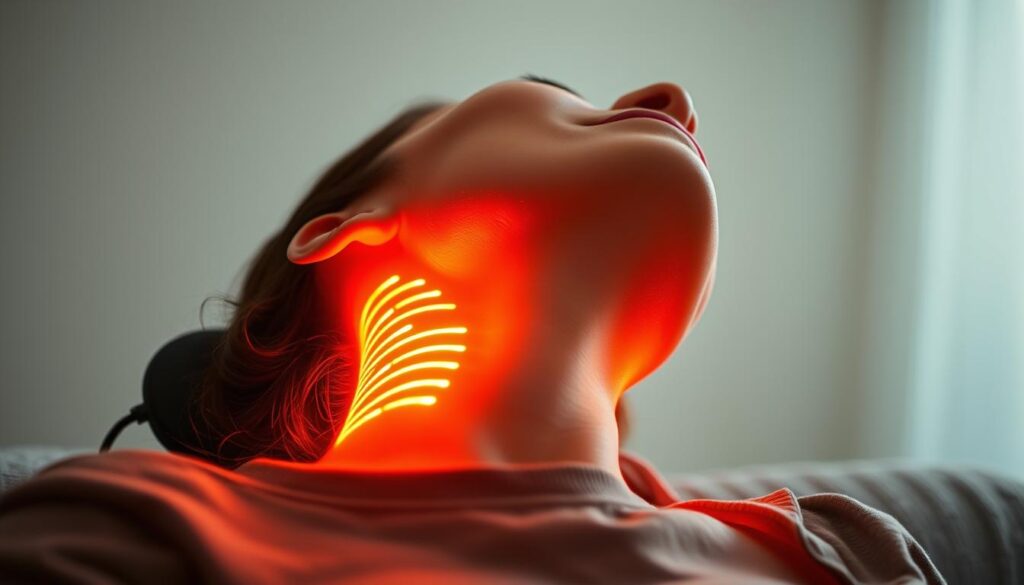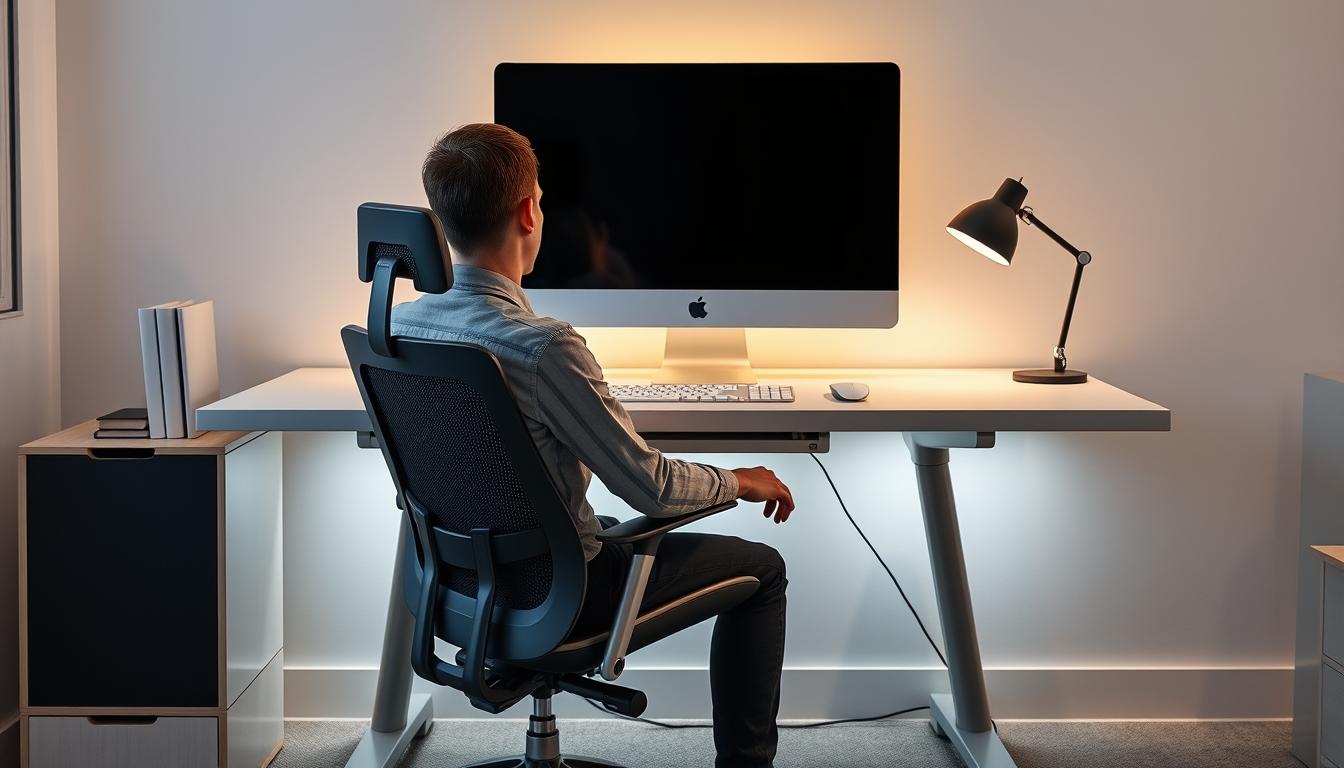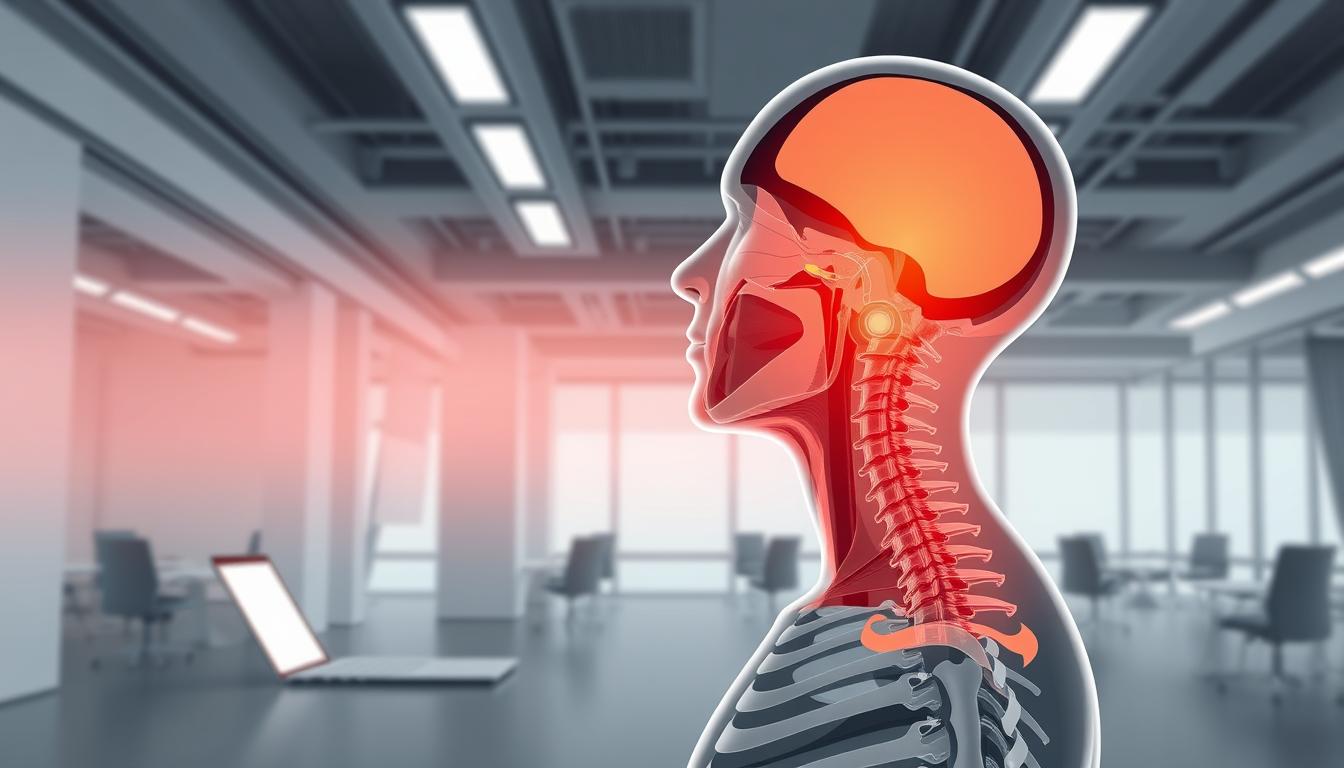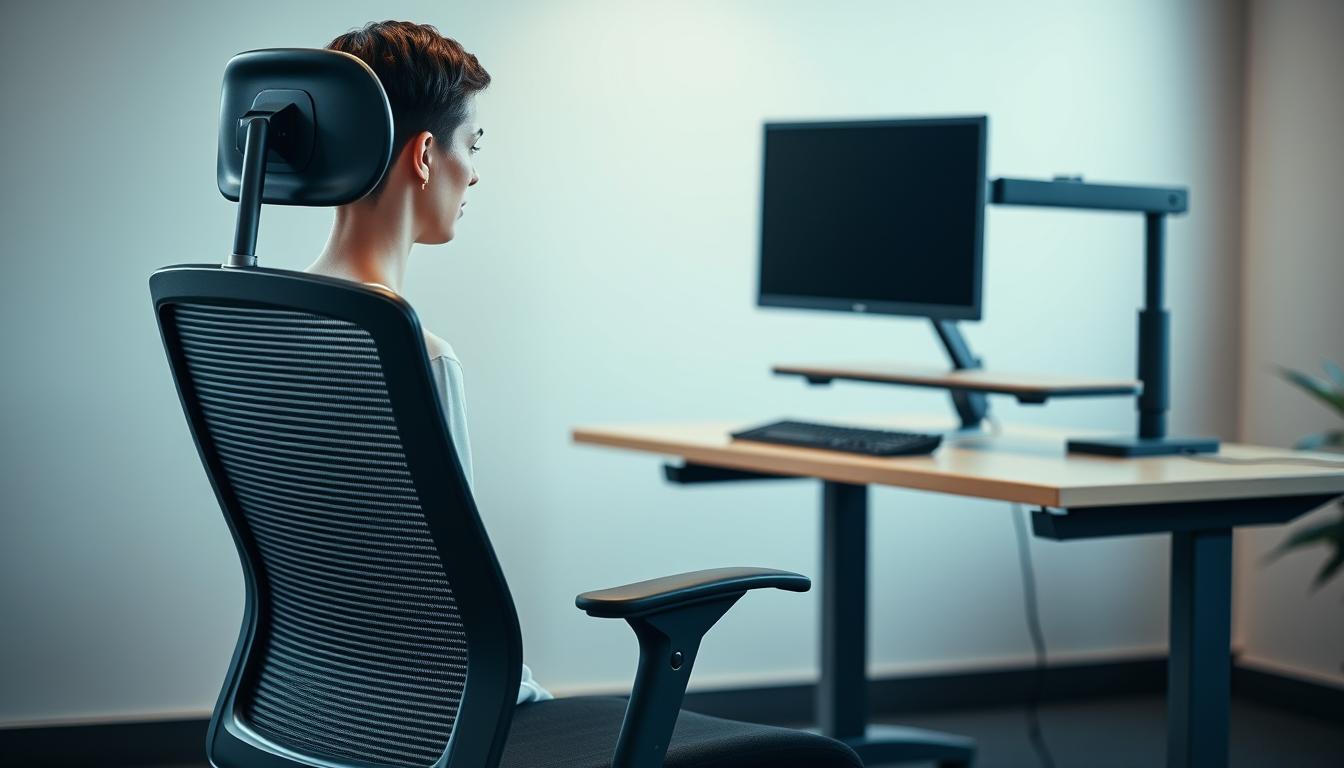More and more, people feel pain from bad posture, mostly when working from home. This pain, often called tech neck, can turn into serious health problems over time. In this piece, we’ll share ways to stop tech neck. We’ll give you practical tips, fixes for your pain, and how to make your workspace better for your neck. Adding these steps to your everyday life can boost both your neck health and how you feel overall.
Understanding Tech Neck
Tech neck, also known as “text neck,” comes from looking down at our screens for too long. This includes phones, tablets, and computers. It’s marked by neck and upper back pain.
More and more, people are facing tech neck because we use these devices so much. Knowing about tech neck and how it affects us is key. We need to understand its long-term effects on our health.
On average, folks spend over five hours every day on their gadgets. This can lead to lasting pain if we’re not careful. Realizing the importance of being aware of tech neck is the first step. We learn how our daily screen time can make our necks stiff. Learning about this issue helps us find ways to avoid hurting ourselves.
What Causes Tech Neck?
Tech neck happens when we strain our neck and upper back because of bad posture. This is often due to looking at screens too much. People may not realize they’re doing it when they tilt their heads down to see their phones. Or when they slump in their chairs while using computers. Knowing the main causes of tech neck can help us prevent it.
Some big reasons for tech neck include:
- Looking down at phones or tablets for a long time.
- Using chairs that don’t support the back well.
- Not moving or stretching enough during the workday.
Other actions, like carrying heavy bags or holding a phone between your shoulder and ear, can make it worse. By understanding what leads to tech neck, we can change our habits. This can lower our chances of getting tech neck.
Signs and Symptoms of Tech Neck
Knowing the signs of tech neck is key to getting better quickly. You might feel a stiff or sore neck and shoulders after looking at screens too much. This can also cause headaches that make everyday activities hard.
Another symptom is weak muscles in your upper back. This means your muscles are strained from not sitting right. If your neck doesn’t move well, you might get upset and lose focus. Sometimes, you might feel numb or tingly in your arms because of nerve issues.
If these neck pain signs keep happening, it’s important to take steps to feel better. This helps stop bigger health problems later on.
How to Avoid Tech Neck While Working From Home
To avoid tech neck at home, focus on your workspace setup. Make sure your screen is at the right height. This keeps your neck comfortable and prevents strain. Also, remember to sit up straight to avoid discomfort and long-term problems.
Adjust Your Screen Height
Keep your computer or laptop screen at eye level. This helps you keep your neck straight and stops you from bending forwards. If you’re on a laptop, a stand can help reach the perfect height. For phone users, hold your device higher to avoid looking down too much.
Maintain Proper Posture
Good posture significantly reduces neck strain. Keep your shoulders back and your chin in. Make sure your ears are in line with your shoulders. This ensures your spine is just right, protecting you from tech neck. Always check how you’re sitting during the day to correct any slouching.
The Importance of Regular Breaks
Taking breaks often is key to reducing the bad effects of too much screen time. It helps ease problems from tech neck. By taking regular pauses, your muscles relax better. This lowers tension in your neck and shoulders.
Keeping up with this habit improves comfort and work performance.
Set a Timer for Breaks
Using a timer reminds you to take breaks from your desk. Try to pause every 30 to 60 minutes. This structured break method refreshes your body and mind.
It also cuts down the chances of getting tech neck.
Incorporate Movement into Your Day
Adding some movement while you work boosts your health. Do simple exercises like neck stretches, walking, or shoulder rolls. These movements help with tech neck relief.
This way, your muscles become less tight. Your flexibility and blood flow get better too. This greatly improves your health.
Strengthening Exercises for Neck Support
Doing specific neck exercises is key for stronger neck support and better posture. These exercises ease the discomfort of tech neck. They keep the neck and upper back flexible and strong through stretching and strengthening.
Neck and Upper Back Exercises
Working on your neck and upper back strengthens muscles and aligns them properly. Try adding these exercises into your workout plan:
- Chin Tucks: Gently push your chin toward your chest while keeping your back straight. Hold for a few seconds, then release.
- Shoulder Blade Squeezes: Pull your shoulder blades together, hold for a few seconds, and repeat to enhance upper back strength.
- Neck Side Bends: Lean your head toward one shoulder, hold briefly, then switch sides to increase lateral flexibility.
Incorporating Stretching into Your Routine
Regular stretching helps ease neck tightness and relaxes muscles. Pay attention to these stretches:
- Forward Neck Stretch: Tilt your head forward gently while looking down, allowing the back of the neck to stretch.
- Side Neck Stretch: Reach your right arm under your head, gently pulling to the right, and feel the stretch in the left side. Repeat on the opposite side.
- Upper Back Stretch: Interlace your fingers and stretch your arms forward while rounding your back to engage your upper back muscles.
Optimizing Your Workspace Ergonomics
Creating an ergonomic office setup is key to avoiding tech neck at home. Start with a chair that supports your lower back well. This lets your back keep its natural shape. Make sure your feet are flat on the ground, or use a footrest if needed.
The placement of your monitor is crucial for keeping your spine happy. Place your screen at eye level, about an arm’s length away. This helps reduce neck and shoulder strain, making work more comfy. The position of your keyboard and mouse is also important. They should be close enough so you don’t have to reach and strain.
Making these adjustments to your workspace doesn’t just help prevent tech neck. It also boosts your productivity. Make sure your workspace fits your body to keep your work environment healthy.
Using Technology Mindfully
Being smart about how we use technology is key to avoiding tech neck. Small changes can really help lessen the stress from looking at screens too much. A good tip is to keep devices at eye level to keep the neck straight.
We also need to watch how long we’re glued to our screens. Taking short breaks often can help fix our posture and stop neck pains. Setting a timer to take breaks from screens is a smart move.
Using speakerphone or headphones also makes a big difference. It stops us from holding the phone awkwardly, which can cause neck strain. This way, we can use technology comfortably without hurting our necks.
Heat and Cold Therapy for Relief
Using heat and cold therapy can help manage tech neck discomfort. These methods reduce pain and make the neck and shoulders feel better. They also improve how easily you can move.
When to Use Heat Therapy
Heat therapy works great for easing tight muscles and boosting blood flow. You can try these ways:
- Putting a heating pad on your neck for 15-20 minutes.
- Taking warm showers to loosen muscles.
- Using heat wraps when you sit or stand a lot.
Doing heat therapy after exercises helps make muscles more flexible and relaxed.
When to Use Cold Therapy
Cold therapy is best for lessening inflammation and swelling. Try these approaches:
- Placing an ice pack on the sore spot for 15-20 minutes at the start of pain.
- Applying cold compresses after working out to reduce swelling.
- Wrapping ice in cloth to protect your skin.
Mixing cold therapy with heat therapy after a few days is a great way to relieve pain and stiffness.

Consulting Professionals for Chronic Pain
If tech neck symptoms get worse, it’s important to get professional help. Getting help early not only eases pain but also helps prevent more problems later. There are many treatments to fit what each person needs.
When to See a Chiropractor
Seeing a chiropractor can help with ongoing neck pain. They use hands-on methods to fix the spine and better your posture. You should think about seeing one if:
- Persistent neck pain lasting more than a few days.
- Headaches accompanying neck stiffness.
- Decreased range of motion in the neck.
These signs mean you might need special treatment from a chiropractor for a faster recovery.
Physical Therapy Options
Physical therapy can significantly reduce neck pain. A therapist creates exercises just for you to make your neck muscles stronger and more flexible. It’s a good idea to try it if:
- Neck pain interferes with daily activities.
- Improvement is not observed from home treatments.
- There is a desire for a structured rehabilitation plan.
Both chiropractic care and physical therapy offer lasting ease from pain. They help make your neck work better, leading to a life without pain.
Conclusion
To prevent tech neck, start by making small changes to how you set up your workspace. Also, practice good screen habits to reduce the risk of neck pain from too much screen time.
Keeping a good posture, especially when working from home, is very important for your health. Doing exercises and stretches for your neck and upper back helps keep them strong and pain-free.
If you keep having neck pain, it’s wise to get advice from a professional. Adding these good habits to your daily life helps with tech neck. It also makes your overall health better in this digital age.



